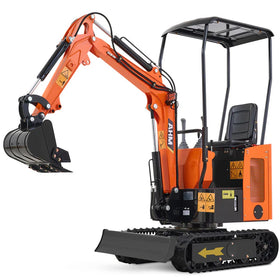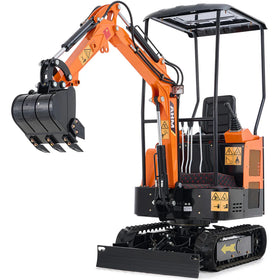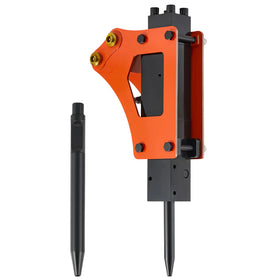Did you know that most farmers spend $15,000 - $25,000 annually on tasks that a single skid steer for farm use could handle for pennies on the dollar, which leads to farm operations bleeding money? Or, have you ever hired a contractor to clean your barn for $500 a day? What if we told you that a farm skid steer would pay for itself in just six months of similar work!
Oftentimes, the difference between farmers who struggle with their daily operations and those who efficiently handle everything themselves comes down to choosing the best skid steer for farm use that matches their actual needs instead of falling for the upselling tactics of dealers.

Why Farm Skid Steer Machines Are Important
In the old days, farming relied on specialized equipment for every task. In contrast, today's smart farmers use one versatile machine to replace all those expensive tools. Studies by experts show skid steers handle 85% of daily farm tasks more efficiently than dedicated single-purpose machines.
The numbers tell the story: With a farm skid steer, you can save 60% on labor costs compared to manual methods, while eliminating the need for multiple machines that each cost upwards of $8,000.
Where skid steers shine:
- Barn cleaning: 8 hours of manual work becomes 2 hours with proper attachments
- Hay handling: Move 4-6 ton loads vs. 50 lb manually
- Feed distribution: Cover 50 acres in 3 hours vs. a full day of manual work
- Transporting materials: Navigate around spaces that tractors simply can't reach
Best Skid Steer for Farm Use: Key Factors That Actually Matter
Size and Weight
Operating weight: 1,500-2,500 lbs of operating weight will provide the lifting power you need without destroying your fields. Lighter machines can't handle real farm loads, while heavier units may compact soil and get stuck in soft ground.
Machine Width: A skid steer with a width of 45-48 inches can fit through standard farm gates and barn doors while maintaining stability. Most farm operations have 8-foot openings - so anything wider won't be able to access livestock areas.
Lifting capacity: 800-1,000 lbs is more than enough to handle 90% of farm materials. For example, hay bales weigh 500-1,200 lbs, feed pallets average 1,000 lbs, and manure loads typically run 800-1,500 lbs.
Power and Performance
Engine horsepower: 20 - 30 HP can handle demanding farm attachments without wasting fuel. Smaller engines may struggle with augers and brush cutters, while larger engines burn unnecessary fuel for routine tasks.
Hydraulic flow rates: 12 - 16 GPM support agricultural attachments without requiring expensive electrical upgrades that many farm operations can't accommodate.

What Skid Steer Attachments Do You Need For Farm Use?
Despite what the attachment salesman says, you only need 4 - 5 main attachments to handle real farm work efficiently, not 20 specialty tools that will start collecting dust eventually. Buying smart means starting with the basics and adding attachments based on what you actually use.
Essential attachments for farm operations:
Standard Bucket ($800 - $1,200):
- 8 - 12 cubic foot capacity handles soil, feed, bedding, and construction materials
- Go for a smooth edge for fine materials, and a toothed edge for digging
Pallet Forks ($600 - $1,000):
- Essential for handling hay bales, feed bags, and warehouse operations
- 2,000+ lb capacity handles typical agricultural loads
Grapple ($1,500 - $2,500):
- Combines the functions of a bucket and a fork for versatile material handling
- 72 - 84 inch opening handles round bales and helps with brush removal
Specialty attachments:
- Auger drive ($1,500 - $2,500) - planting fence posts, trees, and drainage work
- Brush cutter ($2,000 - $3,500) - pasture maintenance and roadway clearing
- Manure spreader ($3,000 - $5,000) - fertilizer distribution
Do You Need Insurance for Your Farm Skid Steer?
Here's what most farmers don't realize - there's no federal law requiring farm equipment insurance in the United States. However, 38 states have specific liability requirements when farm equipment operates on public roads, and 12 states mandate workers' compensation insurance if you hire seasonal help.
The reality gets messier when you look at the numbers. According to Garrett Insurance data, about 1,000 pieces of heavy equipment, including tractors and skid steers, are reported stolen monthly, making farm equipment the third most stolen heavy machinery category.
Coverage types you actually need:
- General liability insurance ($525-$900 annually) - for property damage and injury protection
- Equipment theft/damage insurance ($200-$500 annually) - to protect your investment
- Commercial auto insurance ($400-$800 annually) - when transporting the skid steer off-farm
AHM SS-38: The Affordable Skid Steer For Farm Use from AHM
The AHM SS-38 delivers everything farmers need without the premium brand markup:
Farm-specific design features:
- Reliable and powerful 23 HP Briggs & Stratton engine
- 827 lb lifting capacity handles hay bales, feed pallets, and typical farm materials efficiently
- 45.3-inch width fits through standard farm gates while maximizing stability and lifting power
- 1,733 lb operating weight
Real-world performance:
- 7-hour runtime per tank lets you work throughout the day
- Climbing capability of up to 30 degrees
- Universal attachment system works with standard attachments from multiple manufacturers
Cost advantages for farmers:
- $5,000-$7,000 savings vs. major brands, which allows you to invest in essential attachments
- Local parts availability reduces downtime and service costs
- Simple maintenance using standard fluids and common parts keeps operating costs low
Warranty protection:
- 1-year comprehensive coverage plus lifetime technical support
The Bottom Line
Picking the best skid steer for farm use isn't all about buying the biggest or most expensive machine - it's about matching capability to your actual needs while keeping costs under control.
Most farms only need 800-1,000 lb lifting capacity, 20 - 25 horsepower, and 45 - 48 inch width to handle 90% of agricultural tasks efficiently. Skid steers like the AHM SS-38 deliver exactly these specifications at a price that makes financial sense for working farmers.
Instead of financing a $12,000 - $15,000 premium brand machine, smart farmers buy from AHM and invest the savings in attachments that will multiply their operational capabilities. Sometimes, that can be the difference between equipment that pays for itself and one that runs you more into debt.
Consider these tips on how to operate a skid steer loader.








